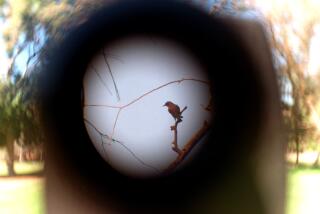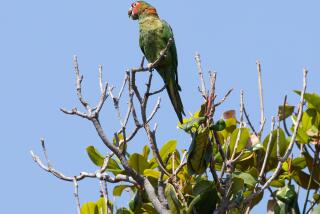On a Balinese Tour, Hours Fly By With the Birds
- Share via
UBUD, Indonesia — I don’t know a sparrow from a swallow, a crow from a crane, a loon from a lark. When I see a pretty bird, the closest I come to a scientific identification is, “Hey, look at that pretty bird!” So when I got a chance to follow an expert bird-watcher, I seized it like a hawk.
Andrea and I traded the sparkling streets of Singapore for the lush landscapes of Bali, the best known of Indonesia’s 13,700 islands. Bali was always on our itinerary, but weather caused our geographical jump backward. We could have fit the island in last winter on our way from New Zealand to India, but we wanted to visit here during the dry season.
After landing in Denpasar, we headed north into the foothills to Ubud, a sprawling town and the center of Balinese art and culture. Seeking a respite from the traffic and congestion strangling this island many still call paradise, we signed up for a four-hour hike with Bali Bird Walks. The guided trek--$33 per person, lunch included--promised to put us within sight of about 30 of Bali’s 300 bird species.
Our guide for the morning was Sumadi, an enthusiastic woman enthralled by birds for as long as she can recall. As a child, she accompanied her parents to work in the rice paddies, where she observed the traits and habits of the birds that soared and streaked around her. She later met Victor Mason, an English ornithologist and Bali resident who taught her the English and scientific names of the many species she had studied informally. The women of her village chide her for being unmarried at 32, but she enjoys her freedom, she said. A husband would not have allowed her to travel to the nearby island of Java to see the peacocks or to venture out for days to capture a glimpse of the endangered Bali starling, her island’s only endemic bird.
Sumadi handed each of the four members of our group a pair of binoculars--devices I had previously used mainly at rock concerts and horse races--and led us up a dirt path through rice paddies fringed with coconut palms and banana trees. Almost immediately, she saw one of the more spectacular birds found on Bali, the Java kingfisher.
“Do you see it, Mike?” Sumadi asked excitedly, grabbing my arm. I trained my binoculars on the distant darting and dipping bird, and my eyes met with a riot of color: dark brown head, cinnamon throat and breast, cobalt blue belly, purple back, light blue wings and tail, red bill and feet. Tingles shot through my limbs. “Yes, I see it,” I said, instantly grasping the thrill of birding.
Sumadi pointed overhead to three domed nests clinging to swaying palm fronds. They were the homes of streaked weavers. The gold-crowned male of the species is polygamous, but he must build a separate nest for each wife he takes. The female inspects the nest, ensuring it meets her approval, before allowing her mate to fly off in search of another companion.
When Andrea and I arrived in Bali, we were struck by the lovely aesthetics: cut fresh flowers on the bed, intricately carved garnishes on the dinner plate. That sense of decoration extends to the fields, where farmers adorn the edges of their land with flowers such as hibiscus, gloriosa lilies and stars of Bethlehem. Each day, the farmers offer some of the flowers to Dewi Sri, Hindu goddess of rice, setting them on simple wooden altars built in the rice paddies.
Our bird-watching group climbed the gentle slope, pausing to admire whatever birds flashed in view: fan-tailed warblers, Javan pond herons, scaly-breasted munias. We descended to a small stream, where Sumadi pointed out other fauna and flora:: a fire-red Malay lacewing butterfly fluttering in the shadows; a vibrant yellow and black spider spinning its web; a mimosa plant, whose feathery leaves close tight at the slightest touch. Everywhere we turned, there was some brilliant bit of nature that I would not have noticed the day before.
Back in the rice paddies, we came upon an old farmer. (Balinese farmers tend to be older; the younger generation finds it can earn more in the tourist industry.) He chopped a hole into several coconuts with a hatchet, and we each hoisted one like a bota bag, letting the sticky, clear juice spill down our throats. After the coconuts were drained, the man hacked them open, and we scooped the sweet, gelatinous meat into our mouths using pieces of its shell for spoons.
When we resumed birding, we spotted a long-tailed shrike perched atop a post. The black-masked bird of prey surveyed the field for a smaller bird it might snare with its sharp claws. The shrike would then impale its victim on a thorn, returning to peck at the bird at its leisure.
We later gazed at what I thought were two identical white birds wading in a flooded rice paddy. But a closer look revealed a slight difference: the one with the yellow bill was a cattle egret, and the black-billed one was a little egret. As the hours and birds flew by, I learned to distinguish among many of the species Sumadi had introduced us to earlier.
At the end of the bird walk, I thought of home, San Diego. We live in a neighborhood where the streets are named for birds: Dove, Goldfinch, Ibis and so on. I realized that my lesson in the birds of Bali would not help me in California. I still can’t tell a bluebird from a blue jay. But if a Java kingfisher ever lands in our backyard, I’ll know what to call it.
NEXT WEEK: High as a kite in Bali.
Did you miss a Wander Year installment? The entire series since it began in January can be found on The Times’ Web site at http://vinapk.com/travel/wander.
More to Read
Sign up for The Wild
We’ll help you find the best places to hike, bike and run, as well as the perfect silent spots for meditation and yoga.
You may occasionally receive promotional content from the Los Angeles Times.






